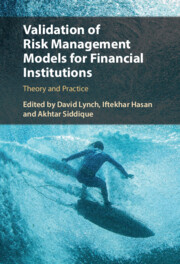Book contents
- Validation of Risk Management Models for Financial Institutions
- Validation of Risk Management Models for Financial Institutions
- Copyright page
- Contents
- Figures
- Tables
- Contributors
- Foreword
- Acknowledgments
- 1 Common Elements in Validation of Risk Models Used in Financial Institutions
- 2 Validating Bank Holding Companies’ Value-at-Risk Models for Market Risk
- 3 A Conditional Testing Approach for Value-at-Risk Model Performance Evaluation
- 4 Beyond Exceedance-Based Backtesting of Value-at-Risk Models: Methods for Backtesting the Entire Forecasting Distribution Using Probability Integral Transform
- 5 Evaluation of Value-at-Risk Models: An Empirical Likelihood Approach
- 6 Evaluating Banks’ Value-at-Risk Models during the COVID-19 Crisis
- 7 Performance Monitoring for Supervisory Stress-Testing Models
- 8 Counterparty Credit Risk
- 9 Validation of Retail Credit Risk Models
- 10 Issues in the Validation of Wholesale Credit Risk Models
- 11 Case Studies in Wholesale Risk Model Validation
- 12 Validation of Models Used by Banks to Estimate Their Allowance for Loan and Lease Losses
- 13 Operational Risk
- 14 Statistical Decisioning Tools for Model Risk Management
- 15 Validation of Risk Aggregation in Economic Capital Models
- 16 Model Validation of Interest Rate Risk (Banking Book) Models
- 17 Validation of Risk Management Models in Investment Management
- Index
- References
9 - Validation of Retail Credit Risk Models
Published online by Cambridge University Press: 02 March 2023
- Validation of Risk Management Models for Financial Institutions
- Validation of Risk Management Models for Financial Institutions
- Copyright page
- Contents
- Figures
- Tables
- Contributors
- Foreword
- Acknowledgments
- 1 Common Elements in Validation of Risk Models Used in Financial Institutions
- 2 Validating Bank Holding Companies’ Value-at-Risk Models for Market Risk
- 3 A Conditional Testing Approach for Value-at-Risk Model Performance Evaluation
- 4 Beyond Exceedance-Based Backtesting of Value-at-Risk Models: Methods for Backtesting the Entire Forecasting Distribution Using Probability Integral Transform
- 5 Evaluation of Value-at-Risk Models: An Empirical Likelihood Approach
- 6 Evaluating Banks’ Value-at-Risk Models during the COVID-19 Crisis
- 7 Performance Monitoring for Supervisory Stress-Testing Models
- 8 Counterparty Credit Risk
- 9 Validation of Retail Credit Risk Models
- 10 Issues in the Validation of Wholesale Credit Risk Models
- 11 Case Studies in Wholesale Risk Model Validation
- 12 Validation of Models Used by Banks to Estimate Their Allowance for Loan and Lease Losses
- 13 Operational Risk
- 14 Statistical Decisioning Tools for Model Risk Management
- 15 Validation of Risk Aggregation in Economic Capital Models
- 16 Model Validation of Interest Rate Risk (Banking Book) Models
- 17 Validation of Risk Management Models in Investment Management
- Index
- References
Summary
Retail credit risk is an important risk for many banks. This chapter describes various retail credit risk models in great detail and reviews the ways they may be validated. Validation principles are described for models used for risk management, stress testing and other applications. The classes of models include both static scoring models and multi-period loss forecasting models. Within the latter class, roll rate model, vintage-based model, and various other models are described. Account/loan level models are also described, including the Cox Proportional Hazard rate model and multinomial logit model. In each case, the authors discuss the academic underpinnings, the industry usage, and choices that are commonly made under various circumstances. The role of data in determining these choices is also discussed.
Keywords
- Type
- Chapter
- Information
- Validation of Risk Management Models for Financial InstitutionsTheory and Practice, pp. 175 - 231Publisher: Cambridge University PressPrint publication year: 2023



